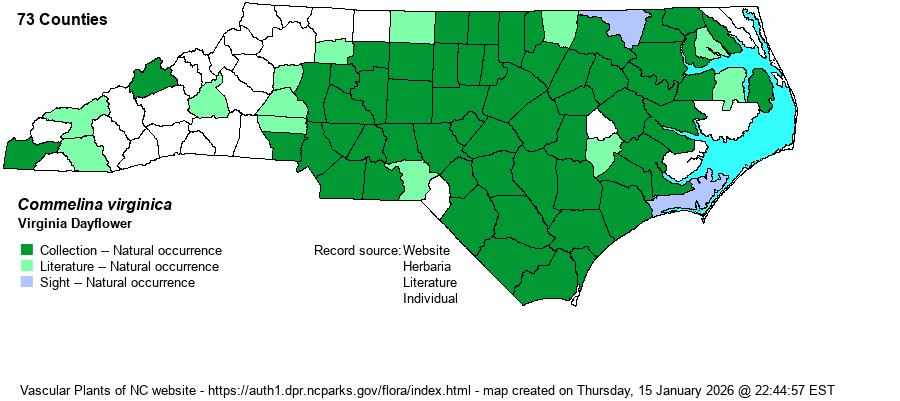| Author | L. | |
| Distribution | Found throughout the Coastal Plain and the eastern two-thirds of the Piedmont, with a known record from the extreme southwestern Mountains ("moist area beside road between Murphy and Tipton" in 1948) and in Madison County (rich woods along road near the French Broad River). Generally absent in the western Piedmont and Mountains, though there are accepted photo records on iNaturalist from a few places there (natural sites?). Scarce in the northeastern Tidewater region and the Outer Banks.
This species has a wide range in the southeastern states. It ranges north to NJ, westward to KS, and south to central FL and eastern TX. | |
| Abundance | Common in the western and central Coastal Plain and fairly common in the Piedmont. Uncommon in the eastern part of the Coastal Plain, being absent on coastal islands. Disjunct and extremely rare in the southwestern and central Mountains. | |
| Habitat | This is one of the more common herbaceous species growing in deep shade of wet woods, shores of rivers and streams, in drier parts of swamps, floodplain pools and oxbows, and other places within floodplains that contain standing water. It can grow in tidal swamp forests, but usually it is found where the water is standing and in moderate to heavy shade. |
| Phenology | Blooms and fruits from July to October. | |
| Identification | For much of the first half of the growing season, someone who walks in bottomlands or drier parts of swamps may often see plants growing in pools with a few scattered, shiny and entire lanceolate or ovate leaves with parallel veins. Some of these might be grasses, a very few might be rare species of Platanthera orchids, but many will likely be this widespread species. In summer it reaches 2-2.5 feet tall, much taller than the others in the genus; and it often grows in dense, monoculture stands. The leaves reach about 4 inches long and 1-1.5 inches wide, a few of them scattered on the stem. One to several moderately large medium to light blue flowers are near the top, growing out from a leaf-like spathe. All three petals are blue in this species, and the lower petal is nearly as large as the top two; the flower averages about 1 inch across. The other NC species of dayflowers (Commelina) are found either in dry and sandy/rocky soil or in disturbed places. The exotic C. communis could grow in shaded wetlands, but it has the lower petal quite small and white in color. Though each Virginia Dayflower plant might not be strikingly beautiful when in bloom, a stand of these in bloom is certain to catch your attention. It takes little time to become familiar with it while walking through wet woods, though rubber boots and bug spray may be helpful before you enter the forest. | |
| Taxonomic Comments | None
| |
| Other Common Name(s) | None | |
| State Rank | S5 | |
| Global Rank | G5 | |
| State Status | | |
| US Status | | |
| USACE-agcp | FACW link |
| USACE-emp | FACW link |

